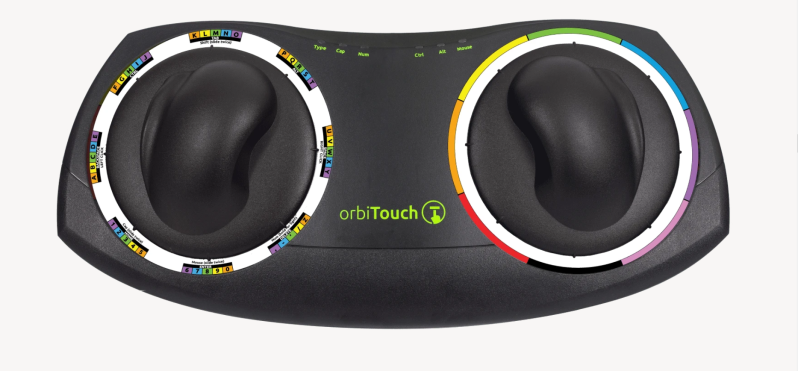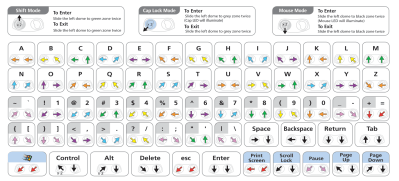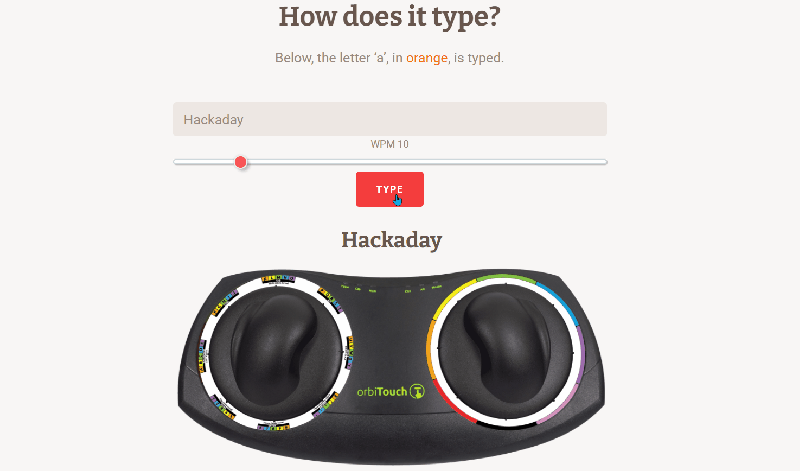I can’t remember how exactly I came across the OrbiTouch keyboard, but it’s been on my list to clack about for a long time. Launched in 2003, the OrbiTouch is a keyboard and mouse in one. It’s designed for people who can’t keyboard regularly, or simply want a different kind of experience.
The OrbiTouch was conceived of by a PhD student who started to experience carpal tunnel while writing papers. He spent fifteen years developing the OrbiTouch and found that it could assist many people who have various upper body deficiencies. So, how does it work?
It’s Like Playing Air Hockey with Both Hands
To use this keyboard, you put both hands on the sliders and move them around. They are identical eight-way joysticks or D-pads, essentially. The grips sort of resemble a mouse and have what looks like a special resting place for your pinky.
One slider points to groups of letters, numbers, and special characters, and the other chooses a color from a special OrbiTouch rainbow. Pink includes things like parentheses and their cousins along with tilde, colon and semi-colon. Black is for the modifiers like Tab, Alt, Ctrl, Shift, and Backspace. These special characters and modifiers aren’t shown on the hieroglyphs slider, you just have to keep the guide handy until you memorize the placement of everything around the circle.

The alphabet is divided up into groups of five letters which are color-coded in rainbow order that starts with orange, because red is reserved for the F keys. So for instance, A is orange, B is yellow, C is green, D is blue, E is purple, then it starts back over with F at orange. If you wanted to type cab, for instance, you would start by moving the hieroglyph slider to the first alphabet group and the color slider to green.
Slide Along the Rainbow
The interesting thing about this keyboard and this particular word is that all the letters for cab are in the first group. The keyboard will let you keep one of the sliders in place if you have repeated colors or letter groups, so you can keep the alpha slider in place and just move the rainbow slider around from green to orange to yellow to spell cab. Let’s watch it type ‘Hackaday’ over and over:

Every letter, number, and special character has an equivalent directional pair that may or may not be easy to memorize. According to the FAQ, the maximum output you can expect from this thing is 30-40WPM. Although it is a combination keyboard and mouse, if you play any games that are more serious than say, Minesweeper,
forget about it. You’ll have to keep switching between keyboard and mouse mode, and it’s a whole thing, and you’re gonna die really quickly.
I think the color code is a great idea, but if you’re colorblind, it’s likely not going to be the keyboard for you. Also, you would have to have the use of both hands and a pretty good amount of coordination to be able to drive this keyboard/mouse hybrid creature. On the plus side, every gesture requires equal force, which is fairly low.
conclusion
Apparently this keyboard rates highly with autistic people because of the alphabetically rainbow-tastic way that the inputs are laid out. Those aesthetic choices are definitely a high point in my book. I think it’s neat that it’s so totally different from any other keyboard. It looks fun to try, at least for little while. Though I can’t imagine typing an entire Hackaday article on one, it looks way more fun to learn than Dvorak. I might buy one someday, but the OrbiTouch is a touch on the expensive side at $399, or you can pick them up used for around $200. They were actually sold out of both the black-and-white versions on the OrbiTouch website at the time of this writing, but there are a few out there on the electronic bay.
So is this keyboard really assistive technology? It kind of depends on your level of functioning. If typing hurts, but you still need to do it, this could be your saving grace. All things considered, I would think that all the joystick motion would aggravate wrist issues or even cause them, but since I haven’t tried actually tried one out, I can’t say for sure. Have any of you tried one?

















Can we customize the top parts with 3d printed ones? I was thinking of something round…
You mean something round (spherical cap-ish) and squishy?
Well, this is HAD so give it a shot…
…but I doubt that it’ll improve your WPM count.
This would be great to see on a gamepad, for typing while I sit back on my couch or in-game contexts. I wonder if WPMs would improve if I just used my thumbs.
Seems like it would be obvious to adapt this to a gamepad… hmm🤔🤔🤔
And that a gamepad would teach/condition kids to use the Keyboard type after they memorize the “key presses”…
This has been re-invented a few times, and yes it seems much better than the ‘here is a keyboard, navigate it with your nintendo controller’ style games usually go with.
I’d still like one to text on the go one handed, imagine a cordless nunchuck with a trigger for each finger, would have enough readily available for most texting and casual entry.
Check out the GP32/GP2x forums, I’m positive this has been invented for the GP2x, which coincidently used an 8 way joystick with 8 contacts, so it could technically do 16 way I Believe
Seems like an ideal use case for something like the (discontinued) Steam controller with two touchpads.
Tab and Backspace are not modifier keys.
Obviously not for color-blind people…
Or dogs.
It looks like the colours are only there as the quickest way to the most used information. It actually comes with a chart with arrows to show all the motions for each key of an ANSI keyboard.
As long as there is a table with all the mappings that is colour blind friendly it won’t really be any different for them to use – steep learning curve to find the right pairings.. Which is the same reason I still haven’t tried a chording keyboard.. Though It seems like a real winner as an idea.
Aw, I was hoping for someone else to buy one and open it. I’ve wondered for years how the actual switch mechanism in those works.
Is it just 8 switches and some slots and rods under each cheek? Is it actually two slider type analog switches? They would both make sense, and are both DIYable, but I’d love to know which the real device uses.
http://makegamessa.com/discussion/2948/text-input-with-a-gamepad
http://www.8pen.com/
https://www.microsoft.com/en-us/research/wp-content/uploads/2016/10/Text-Entry-Using-a-Dual-Joystick-Game-Controller.pdf
Darn you rabbit hole! Still can’t find the software for the GP2x
$399! Is the Government paying for these?
This seems to be ASETINOP, but with four cardinal directions instead of four switches per hand.
If my memory is correct ASETNIOP used multiple keys at a time on one hand, it would be equivalent of moving up and down at the same time on orbitouch. I agree it’s similar, but I don’t think it’s the same. I used to imagine putting some contacts on the back of my phone to do ASETNIOP on the move, but it never really worked. Two little D-pads though, actuated by thumbs, that’s definitely in “it might just work” territory.
What wrist motion? Looks to me like it would use a very small amount of shoulder and elbow motion. What would really make it good would be mouse buttons, wheels and TrackPoint on both handgrips.